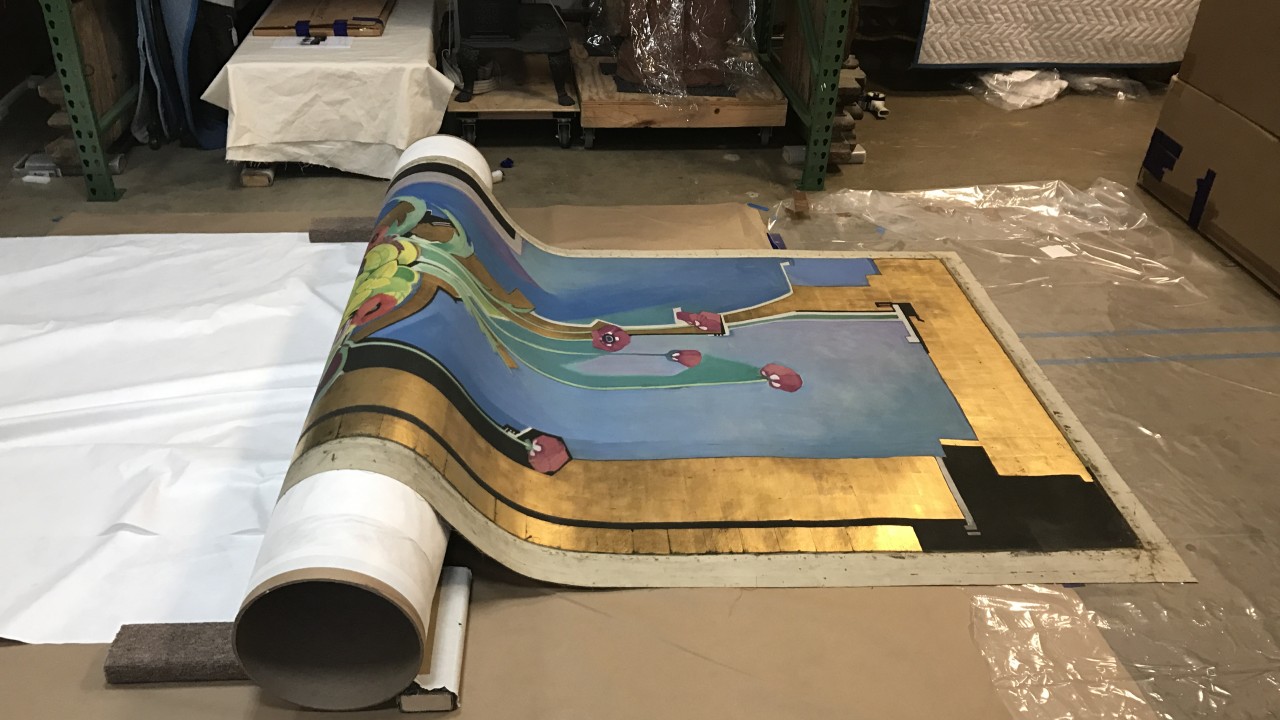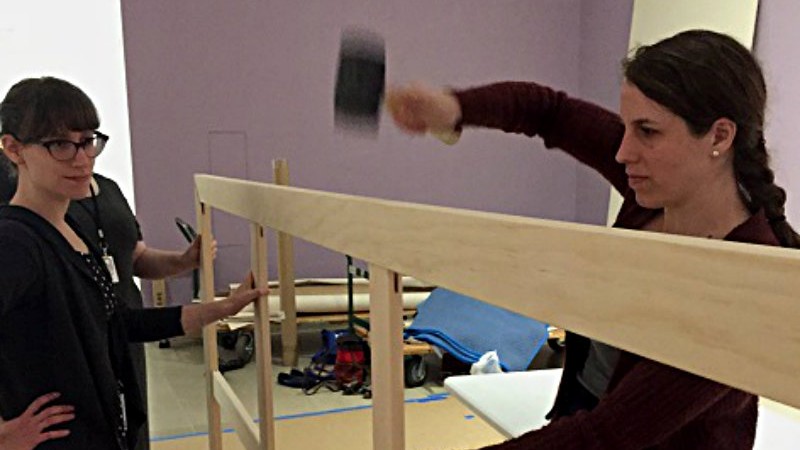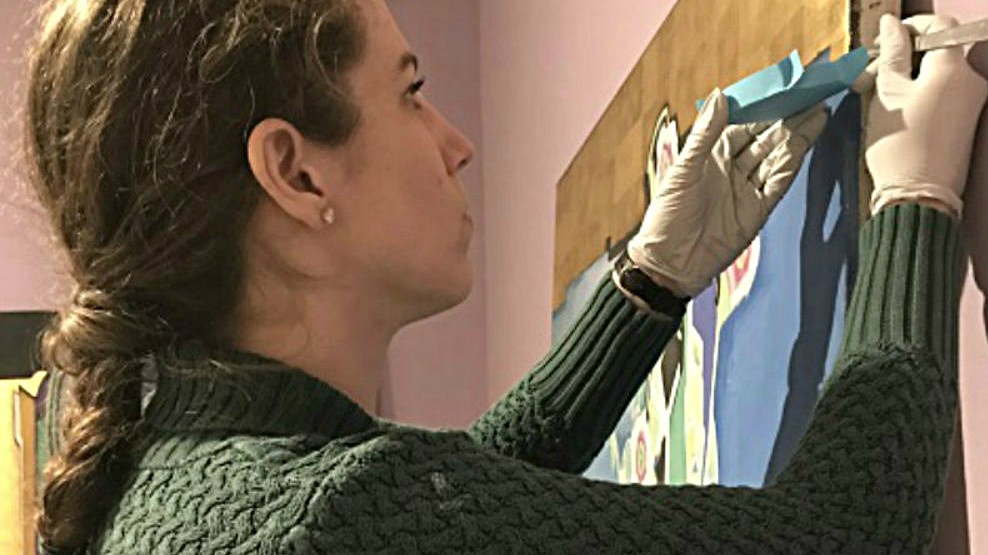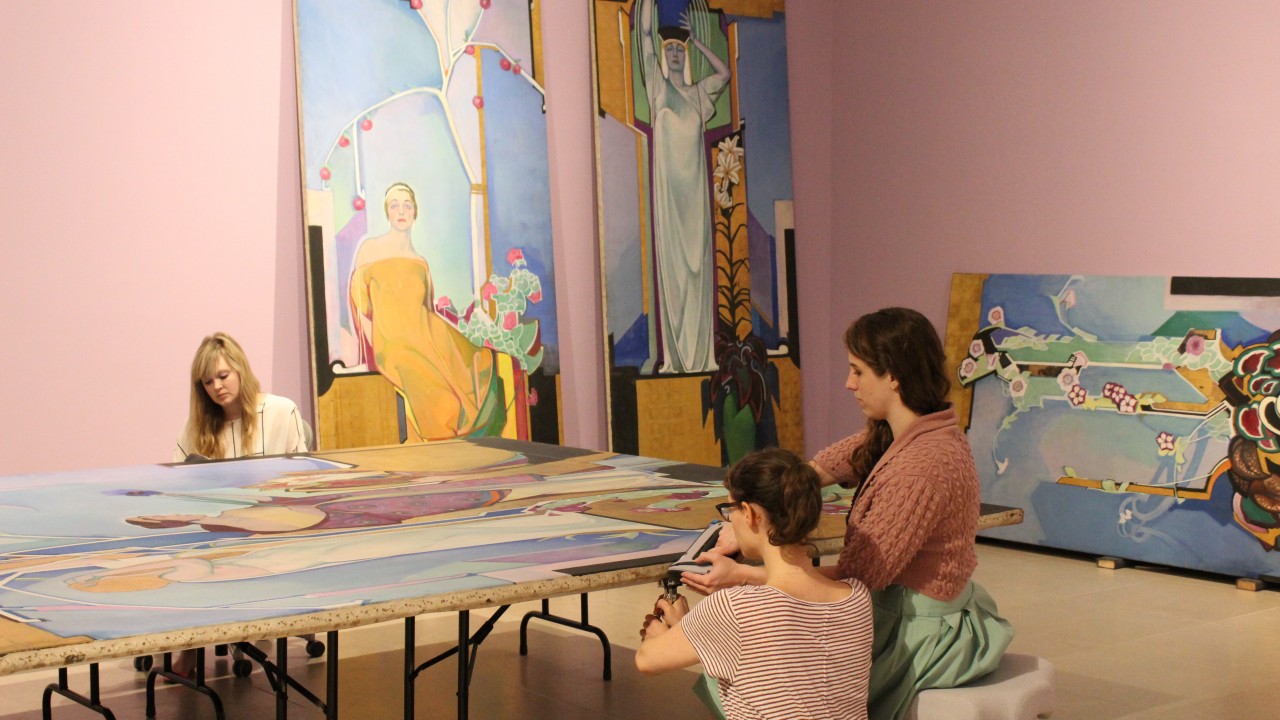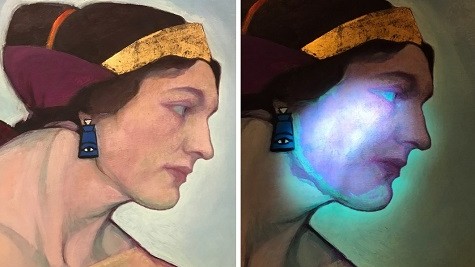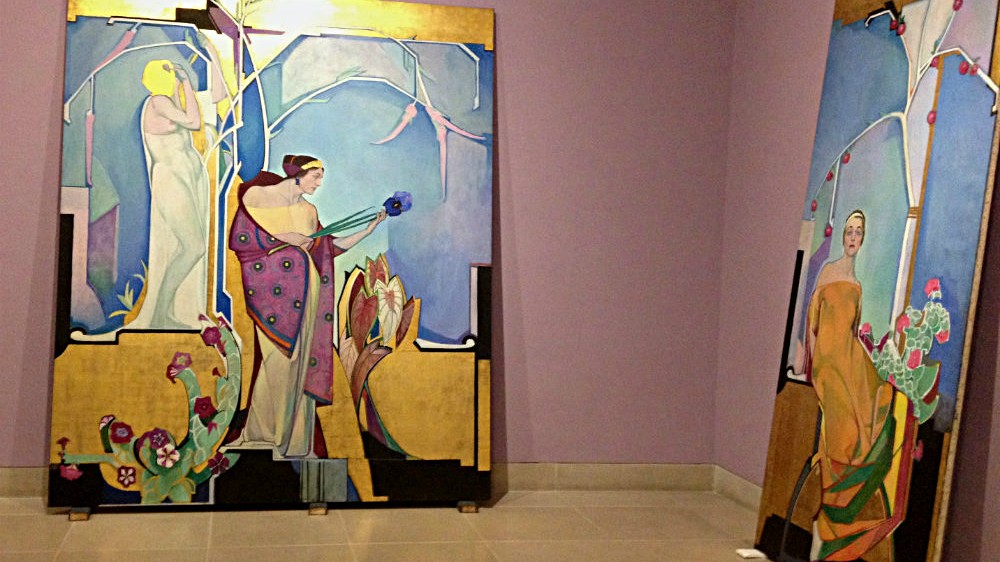She Gets To Touch All The Masterpieces You Don’t
ArtandSeek.net August 31, 2017 51Welcome to the Art&Seek Artist Spotlight. Every Thursday, here and on KERA FM, we’ll explore the personal journey of a different North Texas creative. As it grows, this site, artandseek.org/spotlight, will eventually paint a collective portrait of our artistic community. Check out all the artists we’ve profiled.
You ever have an auto mechanic who’s not simply good at it but clearly seems to love it? He knows the innards, of course, and why they’re there, and he’s deeply curious about your problem – he wants to help – but what he truly wants to do is take this thing apart and understand it. Really understand it. And sometimes, what he does to make it all work, you think, this guy’s an artist.
Laura Eva Hartman is the art mechanic. Painting conservators sometimes have to repair a painter’s artwork pigment by pigment, brushstroke by brushstroke. That takes experience, historic savvy, technical knowledge but also what might be called a get-under-the-hood appreciation of the art form. For this week’s profile in our Artist Spotlight series, Art & Seek’s Jerome Weeks visited with Eva Hartman, associate conservator at the Dallas Museum of Art. She’s been working on a series of paintings that haven’t been seen in public in more than a century. The DMA will be the first museum to display them.

Laura Eva Hartman checking out a Paris street scene by Pissaro in the DMA’s conservation studio.
When she’s working on a painting, Laura Eva Hartman likes to come in early to the DMA’s conservation studio. She unlocks the sliding glass door, opens the window shades in the second-floor room. Sunlight floods in; it’s best for studying paintings. She sets out her tools and whatever she needs just where she likes them.
“Then I put on music,” Hartman says, “usually opera or classical. Sometimes I listen to podcasts but it depends on the task. So if I’m cleaning a painting, I like to listen to music so I’m not distracted.”
Hartman listens to music because she needs calm. Just being in a room with paintings and listening to music is blissful, she says. And cleaning a painting – removing dust and mold, even old varnish – is a common task for a conservator. But it can take weeks. It’s all done centimeter by centimeter with small, soft sponges. And ultimately, every painting in a museum will need to be cleaned at some time. You’re going to need some calm, some bliss.
Then there’s mending the rips in a canvas, another common job.
“The way I mend is I literally weave the canvas back together,” she says. “One thread at a time, under the microscope. You have to be incredibly patient.”
Claire Berry knows Hartman’s many tasks backwards and forwards. She’s been doing them for a couple decades as the director of conservation at the Kimbell Art Museum. During her time, the conservation field has become high-tech.
Examination is one of a conservator’s basic duties: Before a work goes out on loan and when it comes back, it must be examined carefully. When a new exhibition is loaded in and when it leaves. When a new acquisition arrives. If any unexpected changes happen to a work in the permanent collection.

Laura Hartman retouching gold leaf on a Steichen painting. Photo: courtesy of the DMA
“Technical examination,” Berry lists, “examination under the microscope, x-ray radiography, pigment analysis, infra-red reflectography, ultra-violet photography.”
All of this is to understand a painting on the molecular level. Then there’s the structural level, the many levels of base coat and pigment and varnish. Spending so much time with an artist’s different brushstrokes, his or her choice of paints, the stretcher that was bought or made (the wooden framework that keeps the canvas taut and flat), checking the dealer’s stamp or owners’ marks on the back, even discovering the pencil work beneath the painted surface – the underdrawing, it’s called. All this means a conservator may know a painting better than anyone. Even the artist.
“There’s something so intimate and personal about being one-on-one with a painting,” Hartman says. “And being able to see the artist’s hand.”
Sometimes that actually happens. At the DMA, Hartman and four interns have been restoring seven murals by Edward Steichen, a series collectively called ‘In Exaltation of Flowers.” Steichen is best known as a titan of modern photography. But he was also a painter and avant-garde gallery owner. In 1911, Steichen was commissioned for a series of 10-foot-tall paintings by the financier (and future ‘Washington Post’ owner) Eugene Meyer for his New York townhouse. But Meyer ran into debt and sold the townhouse. So Steichen’s paintings were shown only once at a gallery in 1915 – then put away. For more than a century.
“And you see this?” Hartman asks. “This is the mold damage.”
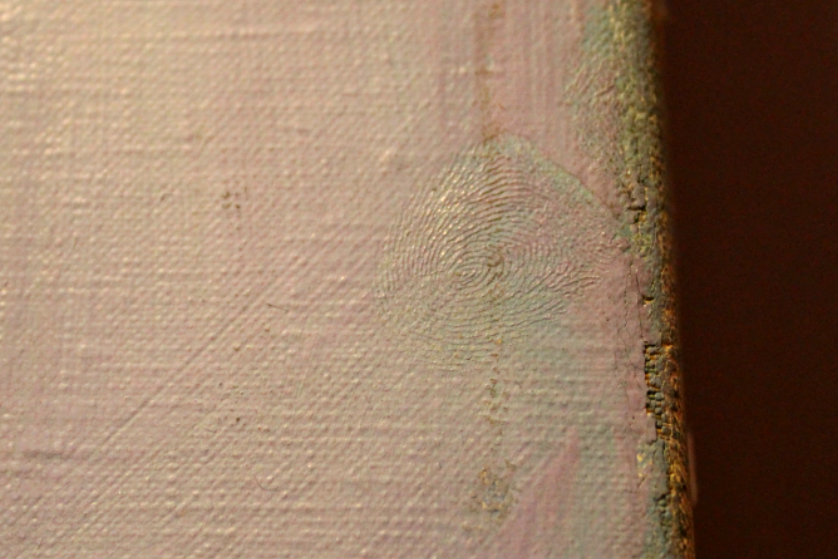
Steichen’s thumbprint. Photo: courtesy of the DMA
A huge photo is laid out on a table, and Hartman is pointing to a light cloudy patch on it. The image is a life-sized photomontage of one of the Steichen canvases, documenting the state of the Steichen painting just after it was first unrolled at the DMA – after 102 years. The canvases were not professionally stored. They had a lot of dust, a few tiny tears. And some mold.
“But other than that,” Hartman says, “beautiful condition.”
These giants do look astonishingly fresh, the paint isn’t cracked, very little of the gold leaf has flaked or tarnished. They’re fresh and full of oddities and puzzles.
Each painting represents a portrait of a member of the Steichen-Meyer circle of friends, including the famous dancer-choreographer Isadora Duncan. We know who the people are; we even know the plants associated with them (each plant was grown in Steichen’s garden – in addition to everything else, he was an amateur botanist).
Beyond that – the symbols, the props, the settings, the order the paintings were supposed to be seen, even the kind of paint Steichen used – it gets mysterious. Was Steichen influenced by Gustav Klimt and the Austrian Seccessionists (all the gold leaf, jeweled colors and symbols)? And how did he manage to anticipate Art Deco – whose beginning is traditionally given as 1925? That’s where the term comes from: the Exposition Internationale des Arts Décoratifs et Industriels Modernes held in Paris that year.
But the Steichen paintings are in such beautiful shape that on the upper right side of one canvas, Hartman spotted a thumbprint in the paint. Steichen’s thumbprint. It was like he’d just been there. In the room.
“When you see something like that,” she says, “it’s so human.”
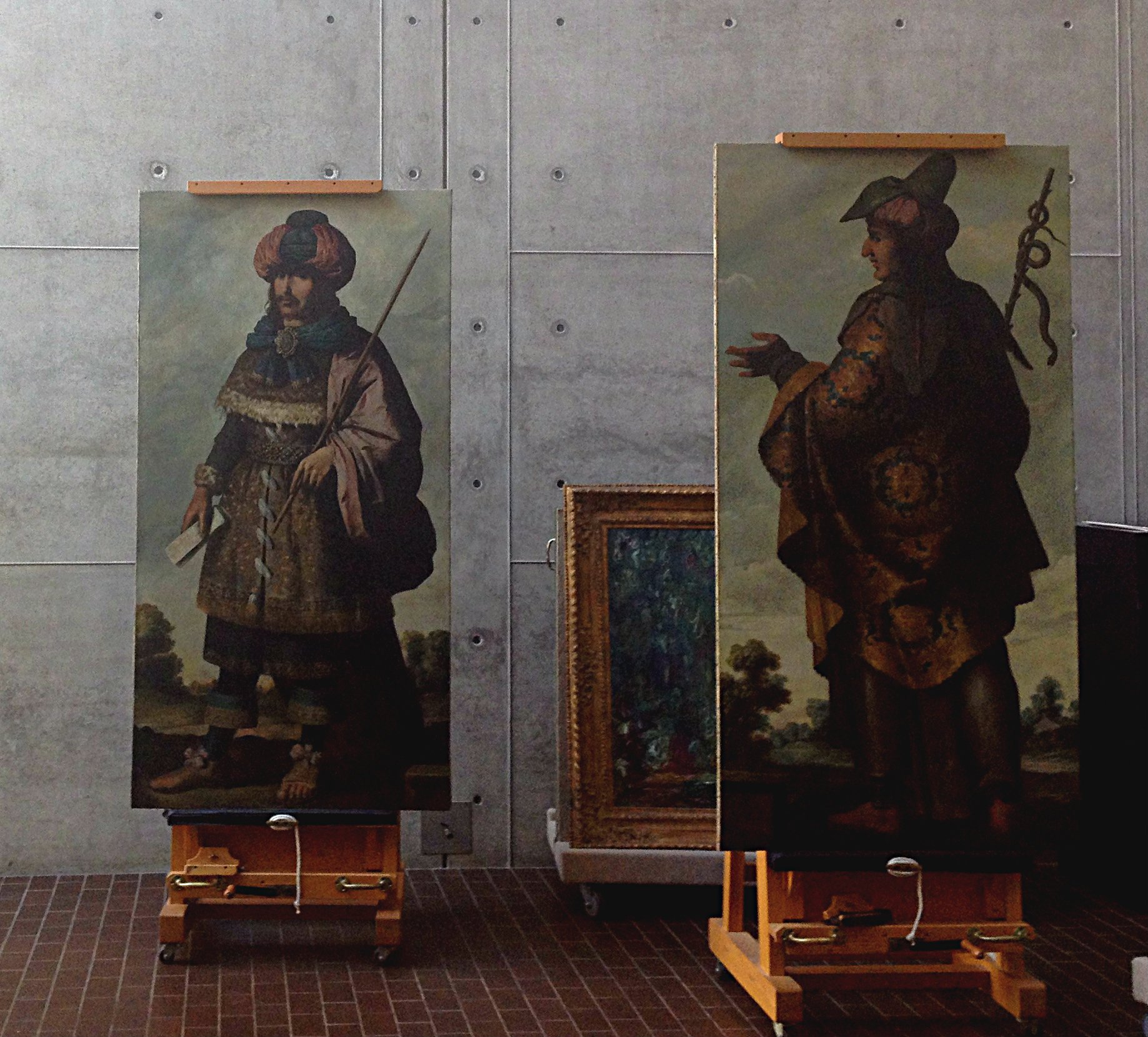
Two of the paintings by Francisco de Zurbaran from his series, Jacob and His Twelve Sons – under examination in the Kimbell’s conservation studio. Photo: Jerome Weeks
Coincidentally, North Texas will be blessed with an extremely rare viewing of a second suite of larger-than-life paintings. The Kimbell’s conservator, Claire Berry, has just finished work on thirteen paintings. It’s a set that will now be seen for the first time in America when SMU’s Meadows Museum opens the exhibition, ‘Zurburan: Jacob and His Twelve Sons, Paintings from Auckland Castle.’ The unwieldy title refers to the fact that this series has been at Auckland Castle since 1756 (only twelve of them, actually, because the thirteenth has been at Grimsthorpe Castle, but that would make the title even clumsier). All thirteen were created by the Spanish Golden Age painter Francisco de Zurbaran in the 1640s. And after the show at the Meadows, they’ll visit the Frick Collection in New York.
But before all that, they stopped off in Berry’s conservation studio for a little check-up.
Much like the Steichens – although, of course, absolutely different in technique and style – ‘Jacob and His Twelve Sons’ are majestic creations. They’re richly detailed, beautifully executed. And they certainly can dominate a room. Berry has lived with these boys for a full year.
“We’ve done a very complete technical study,” Berry explains. “We’ve been trying to learn more about Zurbaran’s creative process. And we’ve learned quite a lot. I wish we could have kept them longer to give them a good cleaning as well.”
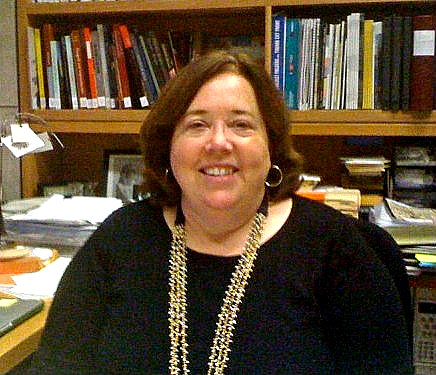
Claire Berry, director of conservation at the Kimbell Museum. Photo: Jerome Weeks
The art conservation world is extremely small. Together, the Kimbell and the DMA have four – and the three at the DMA are all associate or assistant curators. Hartman herself studied at the University of Delaware, one of only three graduate programs in the country – the same program that supplied the four interns working on the Steichens. Following graduation, Hartman had a slew of fellowships and internships in Madrid, the Netherlands, at Yale and New York’s Metropolitan Museum. She was hired at the DMA in 2014, only a year after former DMA director Maxwell Anderson created the conservation studio.
Anderson deliberately made the gleaming-white workspace – and the conservators themselves – a public exhibition. Most museums, if they have a conservation studio, generally keep it out sight. Their prized artworks, after all, generally don’t look their best when they’re being repaired or X-rayed.
But Anderson believed in ‘transparency’ and in the public’s interest in what goes on inside a museum and even in the ‘inherent drama’ of conservation.
The DMA’s exhibition of the Steichen murals, which opens this weekend, takes that transparency one step farther. All seven will be on view in the Horchow Gallery, the first time they’ve been together in public since 1915. And museumgoers can watch conservators continue to work on them – in the gallery.
The paintings will certainly draw visitors. They have towering, statuesque female figures emblazoned with gold leaf. But the work of conservation itself is micro-focused. It’s meticulous.
And it’s slow.
“It is literally like watching paint dry,” Hartman agrees. “But you’d be surprised. I’ve had people watch me for upwards of two hours behind the glass. And they seem fascinated.”
Hartman thinks the fascination comes from seeing a painting no longer on a wall. It’s no longer a distant masterwork. It’s now clearly an object, something a person made, something old and grand, perhaps, but still something that took a lot of time and effort and tools and skills. It’s now an object with weight and dust.
An object now held in a conservator’s human hands.
Did you ever have a day job, other than in art – or a job you had to give up to pursue painting conservation?
I actually used to do some illustrations, but then I’d really gotten into painting as a kid. So I did TA [teaching assistant] and I worked at the University of Delaware and worked for artists’ studios and as a junior docent for the museum.
But I was always kind of involved with art and museums. I knew pretty early on I was interested in art, in paint. I mean, I was drawn to the Dallas Museum of Art early on. My sisters and I used to come here. and I spent a lot of time at the Kimbell, I used to go to Houston at the de Menil. Me and my sisters were constantly visiting museums in the area, I think we were a little spoiled.
You grew up here?
Yeah, partly. It’s very roundabout. I was born in Costa Rica, and then my family moved to the United States. I ended up going through junior high and high school here in Texas.
Where?
In Arlington, of all places. But at that point, after high school, I think I wanted to get away from Texas to see more of the world. They have a great chemistry program and art program in Portland. And I wanted to study chemistry. So, I thought, I’ll go there and live in the Pacific Northwest. It rained all of the time, but it was wonderful. I’m very glad I moved there. It certainly helped me find conservation. It’s typically a field you come to later – after you’ve already become a chemist or art historian. I was lucky to change course so early. So then I moved to Delaware to study it. And from there I went to The Prado in Spain, Yale, the Met in New York.
But my parents are still here, so it was nice to come back here – and to a brand-new studio, which is gorgeous.

The DMA’s second-floor conservation studio. Photo: Jerome Weeks
So if you didn’t really have a day job to give up – outside of painting or studying art – has painting conservation caused you to give up anything else to pursue it? Money? Family life?
In conservation, we travel a lot. One of the most important things is to work with a lot of different people, see a lot of art in person. So you spend a lot of the first years of your career traveling and living in different places. Which is great but it definitely means a loss of stability. Personally, I probably wouldn’t be able to go into an office job and sit in front of a computer all day.
What I mean is I can’t imagine doing anything else, so it doesn’t feel like I’ve given anything up, really – except, maybe the stability. We do travel a lot. But that’s also one of my favorite parts of the job.
Do you have any rituals you follow before you start working – or during your work process?
First, I like to answer all of my emails, so that I’m not thinking about anything else. Then, I put on music – usually, opera or classical. Sometimes, I listen to podcasts – I listen to NPR a lot. But it depends on the task. If I’m cleaning a painting, I like to listen to music, so I’m not distracted. I like to work on paintings earlier in the morning, so I tend to get to work a little earlier than everybody else. Open the shades. Get everything set up just the way I like to work.
So do you play the music over earbuds, headphones or the studio’s speakers?
No, I definitely put it over the system. I think it just creates a really calm environment. It gives you something to have in the background but something that’s not distracting. It’s also just lovely to have music on when you’re looking at paintings and while you’re working on them. Music and paintings.

Laura Eva Hartman examining one of the Steichen paintings ready for framing. Photo: Jerome Weeks
Are you creatively satisfied with painting conservation? Or are you a frustrated artist?
This is very satisfying and creatively very satisfying. I don’t know if I would paint if I hadn’t already painted before I took up conservation. I just love paint and paintings. I think it’s something that I’m so used to and has become such a big part of my life that giving it up was never an option.
But I don’t know. My colleague Mark Leonard also painted [Leonard originally directed the DMA’s conservation studio, he hired Hartman and retired earlier this year]. I think it’s just inherent to any conservator that they make [sculptures or collages or photographs] or they paint. I don’t know if it has to do with creative satisfaction. I think it’s just one of those inherent needs.
Many people wouldn’t think conservation is really an art at all. Part of the art world, certainly, but more a technological application, I suppose. Conservation is where artistry, art history and science come together.
I think that took some creativity [she points to a smaller version of a Steve Parrino painting, a pint-size imitation she created in order study ways to repair the actual, larger version, which was seriously clawed and chewed by a dog.]
But in general, we’re always saying we’re trying to be ‘invisible’ as conservators – compared to the artist. So our hand should be ‘invisible,’ anything we do should be reversible.
I think trying to get to that, maintaining that invisibility – that takes a lot of creativity.

